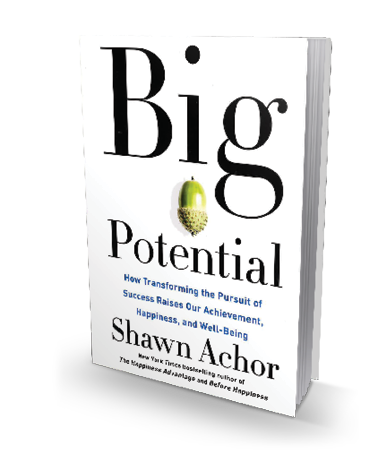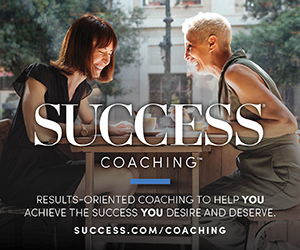If you ever brought home a bad grade, or just one below your normal standard, you probably remember an uncomfortable talk with your parents. They weren’t mad—just disappointed. You hadn’t lived up to your potential.
If you’re a parent now, you might see things the same way. There’s a problem with our overall view of potential, though. We often expect others—or ourselves—to reach that potential independently, as if it’s a solitary journey. We pretend that one’s burden to reach his or her potential falls squarely on that person’s shoulders. To think this way is to be conditioned to achieve what I call Small Potential, or the limited success you can achieve alone. A kid who made a bad grade on a spelling test might’ve done better if he devoted more time to studying in his room, but he also might’ve been more likely to succeed if his parents had studied with him, or if his teacher had paired students together to quiz one another before the test. Instead he was all on his own.
Success doesn’t exist in a vacuum. We spend the first 22 years of our lives being judged and praised for our individual attributes and what we can achieve alone, when for the rest of our lives our success is almost entirely interconnected with that of others.
Big Potential—the real extent of what we can achieve—requires the help of others. It relies on a virtuous cycle, an upward spiral of potential whereby with each success, you garner more resources, which in turn, allows you to achieve greater and greater successes. The people around you can be your resources. And you can be their resource, too, continuing the cycle.
I have spent the past three years crafting a practical approach to Big Potential based on the science behind eight original research projects I have conducted with others and my work at NASA, the NFL, the White House and elsewhere, as well as my conversations with highly successful people including Will Smith, Oprah Winfrey and Michael Strahan.
Here’s what the science clearly shows: Big Potential is a moving target, not a destination, and it is not something you can reach on your own.
Related: Shawn Achor on the Secret to Reaching Big Potential
You want to become a magnet, pulling people toward you and helping them channel their energy toward their Big Potential. By doing this, that collective energy will simultaneously provide you momentum and assistance to reach your goals.
You’ll need people to follow you, people who can rely on you to share the success and whom you can rely on to help you achieve that success in a combined effort. How do you pull people toward your circle, and just as important, how do you make sure they share the same vision as you?
“It’s not enough to tell our children a bright future is possible; we need to help them envision how truly possible that future could be.”
If you plan to walk hand in hand with someone toward a shared goal, one way to draw them in is with the power of storytelling. That is to say, telling the story of positive results yet to come. With any luck, it’s a true story—it just hasn’t come true yet.
You’re probably already familiar with visualization. Any good tennis player, or even an impressively mediocre one like me, knows the key to winning is to first visualize where your serve is going, make good contact with the ball, then follow through fully. Yet too many leaders have only a vague picture of where they want to take their companies or teams. Thus they fail to connect with and inspire their employees, and then they don’t follow through because they believe they have already failed. If the leader simply says, “The future is bright” without providing any of the details, they are unlikely to connect with their team on an emotional level.
Business leaders, teachers, politicians and parents wishing to build a shared vision, create mental models and foster team learning can take much from how the best authors use words to evoke vivid imagery in the collective minds of their readers. Simply saying, “It was a dark and stormy day,” is not nearly as powerful as describing how “the raindrops were drumming against the windowpane the way a concert pianist pounds on the keys.”
If we want people to be excited about the direction we are taking them, we need to similarly elevate their collective vision of what a positive world can look like. For example, a manager might try to describe the effusive, gushing emails employees will receive from grateful clients upon the implementation of the new customer service training, a nonprofit leader might show pictures of smiling recipients while describing the potential impact of a new fundraising initiative, or a coach might describe the thunderous applause that will erupt in the bleachers once the team pushes through their losing streak to win in the playoffs.
Related: The 2 Factors That Determine Your Potential for Success
This is equally true for us as parents. A parent who simply says, “Think how proud you will make yourself if you excel at school,” or, “Imagine how happy you will be when you get into college,” is not inspiring their child to excel nearly as much as the parent who paints a vivid picture of that child standing onstage giving the speech as a valedictorian at high school graduation, or of going to their campus store to buy their first sweatshirt emblazoned with their new college logo, which they will wear to keep warm as they read on the benches outside the library in October. It’s not enough to tell our children a bright future is possible. We need to help them envision how truly possible that future could be.
I once had dinner in Milan the night before a talk with Martin Seligman, the father of positive psychology from the University of Pennsylvania, and Barry Schwartz, the author of the brilliant book, The Paradox of Choice. At one point during the conversation (for most of which I was too nervous to speak), Seligman stated these wise words: “Action is not driven by the past but pulled by the future.” To be honest, I didn’t really agree with him at the time, but now I understand what he meant. We are magnetically drawn toward vivid pictures of the future.
One of the most effective and well-studied ways to vividly envision our futures is to write about it. The act of consciously crafting your narrative of an event—past or future—directs your energy toward it. In one study, researcher Laura King found that when people wrote about their best possible self, the type of person they aspire to become and think is possible to become, their health and well-being significantly improved. And in research done by Kristin Layous, Katherine Nelson, Jamie Kurtz and Sonja Lyubomirsky, when individuals were invited to write once a week about the best future self they could imagine, they needed only a month to significantly elevate their physical well-being, happiness and connectedness—the most crucial components of sustained potential. If you have goals you want to achieve, at work or in your personal life, write about them! And do it as vividly as possible. Think of it as writing a screenplay for a rich Technicolor Hollywood blockbuster starring your best possible future self.
These techniques do more than just help us sustain the gains in the short term; there is lasting impact to our efforts to vividly conceive of a positive future. In one study of people suffering from clinical depression, not only did visualizing increasingly vivid images of the future increase optimism and lessen depression; those effects still endured seven months later.
This finding is so crucial. Perhaps you’ve noticed that we’re in the midst of a tumultuous political cycle. Both sides claim to not be able to envision anything but a disastrous road ahead if the other side has its way. While understandable, this outlook robs us of our energy and only increases the likelihood our fears will come to pass. Only once we can truly see ourselves overcoming whatever challenges we face, can we sustain our efforts to help create a better world.
Related: 7 Ways to Sharpen Your Vision for Success

Adapted from Big Potential. Copyright © 2018 by Shawn Achor. Published by Currency, an imprint of the Crown Publishing Group, a division of Penguin Random House, LLC.
This article originally appeared in the March 2018 issue of SUCCESS magazine.


